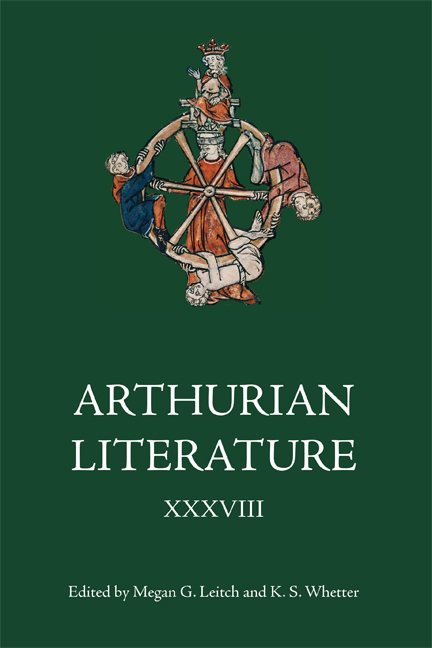Book contents
- Frontmatter
- Contents
- List of Figures and Tables
- Note on the Derek Brewer Prize
- General Editors’ Preface
- List of Contributors
- List of Abbreviations
- 1 The Inaugural Derek Brewer Essay Prize: Animals at the Feast: Strange Strangers and Courtly Power in The Wedding of Sir Gawain and Dame Ragnelle
- 2 The Kindred of a Boy without a Father: Merlin’s British Forebears and Irish Cousins
- 3 Geoffrey of Monmouth’s Subtle Subversion: Active Double- Voiced Discourse in the Historia regum Britanniae
- 4 ‘Cornwall, up in the North’: Geography and Place Names in the Source of the Old Icelandic Brut
- 5 Enacting Arthurianism in the Order of the Garter and Sir Gawain and the Green Knight
- 6 Deviants and Dissenters: Theorizing Shame and Punishment in Malory’s Morte
- 7 Loyalty and Worshyp in Conflict in Malory’s Lancelot
- 8 Emotional Inheritance in Malory’s Morte Darthur: Shame and the Lott–Pellinore Feud
- 9 Navigating and Indexing Arthurian Romance in Benoît Rigaud’s Edition of Lancelot du Lake (1591)
- 10 ‘A great many strange puppets’: Queen Caroline, Merlin’s Cave, and Symbolic Arthurianism in the Age of Reason
- 11 How Galahad Regained his Virginity: Dead Women, Catholicism and the Grail in Nineteenth-Century British Poetry
- Notes
- Miscellaneous Endmatter
4 - ‘Cornwall, up in the North’: Geography and Place Names in the Source of the Old Icelandic Brut
Published online by Cambridge University Press: 10 January 2024
- Frontmatter
- Contents
- List of Figures and Tables
- Note on the Derek Brewer Prize
- General Editors’ Preface
- List of Contributors
- List of Abbreviations
- 1 The Inaugural Derek Brewer Essay Prize: Animals at the Feast: Strange Strangers and Courtly Power in The Wedding of Sir Gawain and Dame Ragnelle
- 2 The Kindred of a Boy without a Father: Merlin’s British Forebears and Irish Cousins
- 3 Geoffrey of Monmouth’s Subtle Subversion: Active Double- Voiced Discourse in the Historia regum Britanniae
- 4 ‘Cornwall, up in the North’: Geography and Place Names in the Source of the Old Icelandic Brut
- 5 Enacting Arthurianism in the Order of the Garter and Sir Gawain and the Green Knight
- 6 Deviants and Dissenters: Theorizing Shame and Punishment in Malory’s Morte
- 7 Loyalty and Worshyp in Conflict in Malory’s Lancelot
- 8 Emotional Inheritance in Malory’s Morte Darthur: Shame and the Lott–Pellinore Feud
- 9 Navigating and Indexing Arthurian Romance in Benoît Rigaud’s Edition of Lancelot du Lake (1591)
- 10 ‘A great many strange puppets’: Queen Caroline, Merlin’s Cave, and Symbolic Arthurianism in the Age of Reason
- 11 How Galahad Regained his Virginity: Dead Women, Catholicism and the Grail in Nineteenth-Century British Poetry
- Notes
- Miscellaneous Endmatter
Summary
Among the first comparative studies dealing with the source of the Breta sögur, the Old Norse–Icelandic translation of Geoffrey of Monmouth's Historia regum Britannie (or De Gestis Britonum), an article published by A. G. Van Hamel in 1936 marked a stepping stone to a deeper understanding of this complicated text. In his study, the scholar came to several important conclusions regarding textual history, such as similarities between the Breta sögur and the Llanstephan 1 version of the Welsh Brut y Brenhinedd. More arguably, yet interestingly, he theorized that the Latin source of the Breta sögur was not the Historia itself but an intermediary Latin text originating from England (more specifically, from Canterbury). He writes: ‘The Latin exemplar of N [the Old Norse text], which we shall denote X, must already have departed in some respects from the original form of the Historia. X shows an interest in English geography and history, especially ecclesiastical history, and an acquaintance with books current in England at the time that cannot possibly be expected from the Norwegian translator.’ The fact that his analysis was based on only one version of the Breta sögur inevitably led him to formulate biased conclusions. But his theory raises important questions: From what kind of source did the first Norse–Icelandic translator elaborate his text? Is there evidence in the Icelandic manuscripts that the ultimate source could have been English?
Other interpretations than Van Hamel's have been formulated since 1936 about the source of the Old Icelandic Brut, trying to date and locate it. Stefanie Würth gives a survey of the existing hypotheses in her 1998 book. In this study, she comes to the cautious conclusion that a complete translation of the Latin text must have been available when the prophecies of Merlin were translated into Icelandic, that is to say, at the turn of the twelfth and thirteenth centuries. But indications regarding the provenance of this source are scarce, though it is a documented fact that clerical and monastic networks played an important part in the transmission of these kinds of materials.
- Type
- Chapter
- Information
- Arthurian Literature XXXVIII , pp. 81 - 123Publisher: Boydell & BrewerPrint publication year: 2023



